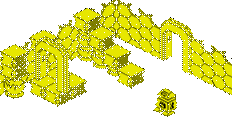Nintendo GameCube
Vital Statistics
Introduced
14th September 2001 (Japan), 18th November 2001 (USA) |
|
![]()
What's it like today?
|
In 2001 Nintendo launched the successor to the Nintendo 64, called the GameCube, following its announcement at E3 in 1999. The primary goal of the new console was to overcome the perceived limitations when programming for the console, thus regaining market share for Nintendo that they had lost during the Nintendo 64's lifetime.
The GameCube was the first console by Nintendo to use DVD technology as its primary media format, replacing the use of cartridges on their earlier consoles, however, the choice was to use proprietary format mini-discs, partially to prevent unauthorized copying and to avoid having to pay license fees to the DVD Consortium. This also meant it could only be used to play GC games, not play CDs or DVDs as the Xbox and PS2 can.
 In the market it competed directly against Sony's PlayStation 2 and Microsoft's Xbox, but remained in third place for most of its life, mostly due to its "family-friendly" appearance and lack of support from some key third-party game developers - this caused it to be more geared to the younger market which at this time was in the minority. Whilst some developers initially released their games for the GameCube, take-up was far less than for the other competing consoles and many of them scaled back their GameCube development or ceased it altogether.
In the market it competed directly against Sony's PlayStation 2 and Microsoft's Xbox, but remained in third place for most of its life, mostly due to its "family-friendly" appearance and lack of support from some key third-party game developers - this caused it to be more geared to the younger market which at this time was in the minority. Whilst some developers initially released their games for the GameCube, take-up was far less than for the other competing consoles and many of them scaled back their GameCube development or ceased it altogether.
 Another strategy that was being adopted heavily by Sony and Microsoft was online connectivity. Unfortunately, Nintendo added this feature to the GameCube rather late in the game (October 2002) with the launch of the GameCube Broadband Adapter or Modem Adapter, resulting in game developers usually releasing offline-only versions of the game on the GameCube platform.
Another strategy that was being adopted heavily by Sony and Microsoft was online connectivity. Unfortunately, Nintendo added this feature to the GameCube rather late in the game (October 2002) with the launch of the GameCube Broadband Adapter or Modem Adapter, resulting in game developers usually releasing offline-only versions of the game on the GameCube platform.
Several accessories were released for the GameCube, including a GameCube Game Boy Player that allowed gamers to play the entire back catalogue of Game Boy, Game Boy Colour and Game Boy Advance games, a wireless WaveBird controller and as attachable LCD monitor. Nintendo later also overcome the lack of DVD playback capability by teaming up with Panasonic to create the Panasonic-Q - a GameCube and Panasonic DVD player in a single unit. This was to be available in Japan only, retailing at $490. It was discontinued in Dec 2003 due to poor sales.
The Games
Throughout its lifetime over 600 titles were released for the GameCube, with sales of over 208 million games. Some of the more popular ones were Metal Gear Solid, Timesplitters 2, Donkey Kong Jungle Beat, Star Wars Rogue Squadron II, Metroid Prime 2 Echoes, Soul Caliber 2, Super Mario Sunshine, and Prince of Persia: Sands of Time.



Original Launch Titles
Luigi's Mansion - Japan, 14th September 2001
Super Monkey Ball - Japan, 14th September 2001
Wave Race: Blue Storm - Japan, 14th September 2001
All-Star Baseball 2002 - USA, 18th November 2001
Batman: Vengeance- USA, 18th November 2001
Crazy Taxi- USA, 18th November 2001
Dave Mirra Freestyle BMX 2- USA, 18th November 2001
Disney's Tarzan Untamed- USA, 18th November 2001
Luigi's Mansion- USA, 18th November 2001
Madden NFL 2002- USA, 18th November 2001
NHL Hitz 20-02- USA, 18th November 2001
Star Wars: Rogue Squadron II: Rogue Leader
Super Monkey Ball- USA, 18th November 2001
Tony Hawk's Pro Skater 3- USA, 18th November 2001
Wave Race: Blue Storm- USA, 18th November 2001











